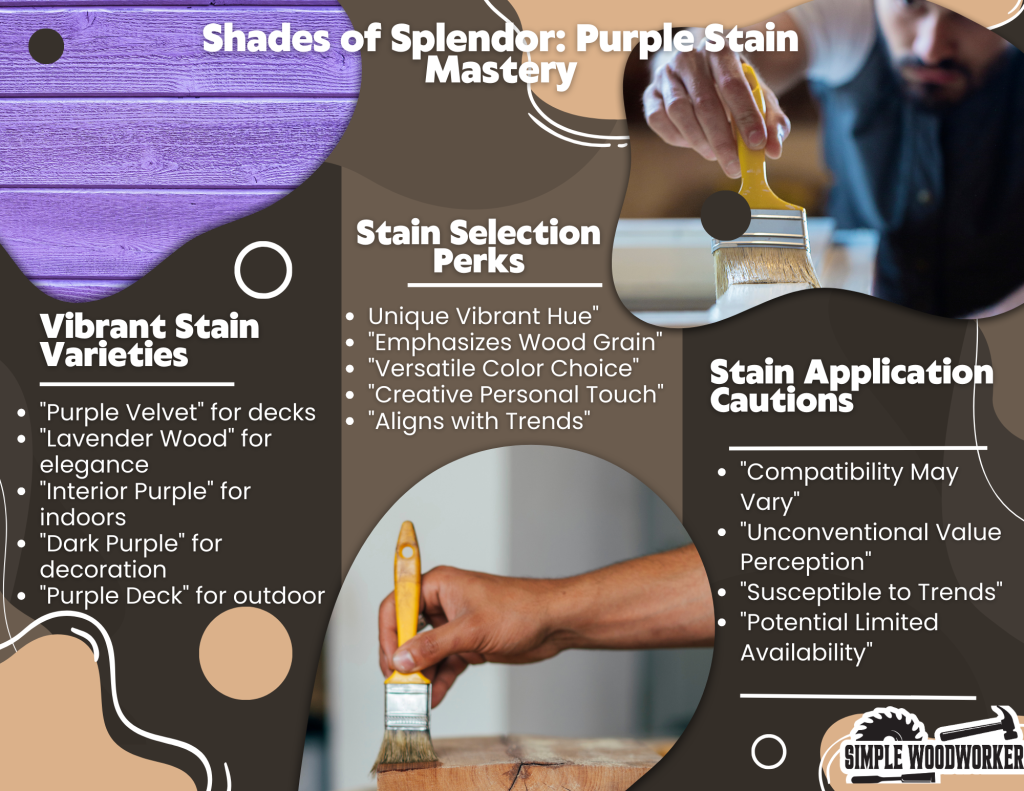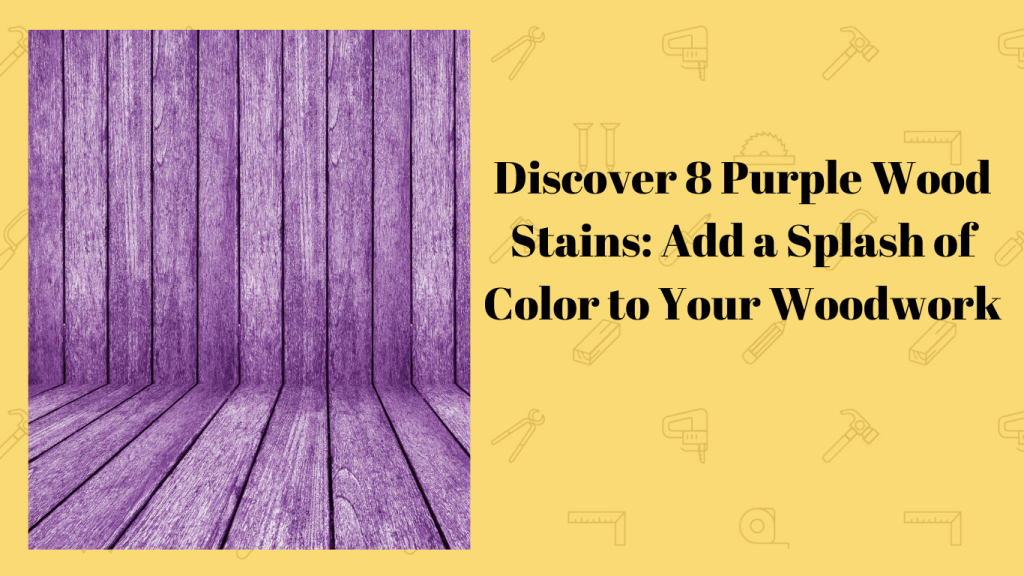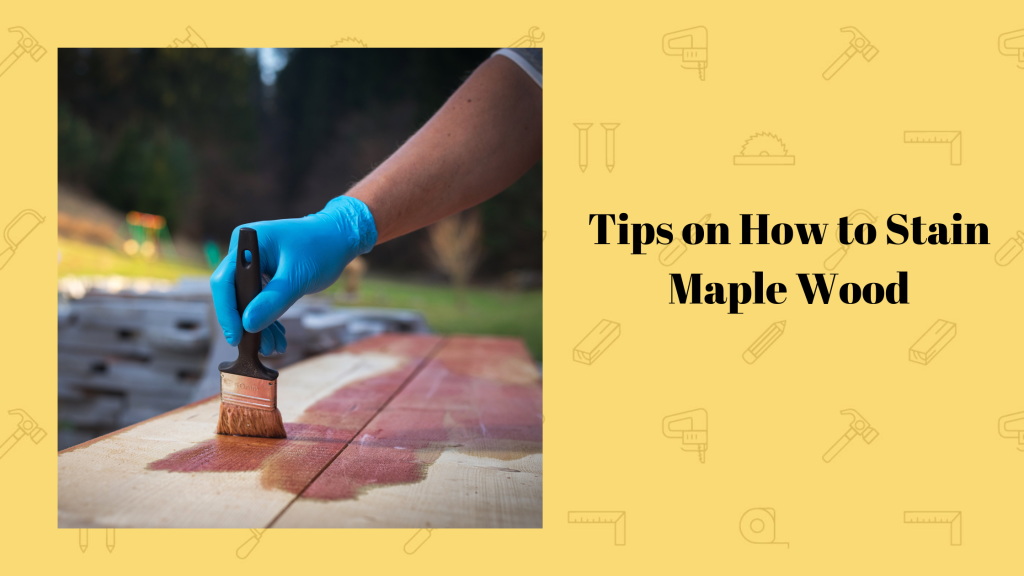How do you choose a purple wood stain, and can that choice fundamentally impact your final product? That’s the million-dollar question!
As in our guide to maple stains, I’ll describe common types of purple stains, and give some advice on when you should choose one over the other.
My background in professional woodworking (where I perfected my millwork techniques, created ornamental trims, and developed my own style) has given me a solid foundation in staining and dyeing my projects.
Read more to find out about 8 purple stains!
Are There Different Types of Purple Wood Stains?
Let’s start with the most essential question: Is there even a big range of purple wood stains to choose from?
Absolutely!
Different stains distinguish themselves by hue (dark, light, etc.), application (interior or exterior, for instance), or wood type.

8 Types of Purple Wood Stains to Consider
Without further ado, let me explain 8 of the top purple stains you can pick:
1. Purple Velvet
Purple velvet is one of the most popular wood dye choices, and it’s especially well-suited for exterior and deck projects.
Reasons I’d suggest using it for outdoor woodworking staining include the easy application to damp decks (a must-have for those working in high-moisture areas), protective sealant ingredients (ensuring a longer lifespan and rot resistance), and its bold, beautiful hue.
A purple velvet stain also works well on concrete, so I’ve chosen it in the past when I wanted a multi-purpose dye for both woodworking and general outdoor construction.
2. Lavender Wood Stain
Lavender is another optimal purple dye choice, easily distinguishable by its trademark soft blue tint.
This is usually seen as a more traditional, classic-looking stain type, so it’s a perfect fit for more elegant interior woodworking projects.
In my home improvement projects, I’ve found the results particularly impressive for window and door frames, since the dye creates a strong aesthetic balance between unobtrusiveness and an attractive look.
Lavender stains also usually offer protective features against rain and wind, so, even though the stain is usually used for interior work, you can easily apply it to outdoor setups too.
3. Purple Interior
As I touched on a bit before, hue isn’t the only factor that divides types of purple stains: There are also functional categories, like interior or exterior.
Purple interior stains are, like the name suggests, optimal for indoor furniture and woodworking.
These dyes often offer benefits like a faster drying time and easy application, but those pros almost always come at the expense of protection against the elements, which is why this type of stain is a poor fit for deck and yard projects.
If you’re interested in interior wood dyes, the TransTint purple dye is a wonderful option.
When I tested it, I was impressed with its easy and straightforward application, rich appearance, and the wide variety of woods it works with.

4. Dark Purple Wood Stain
Moving back to hue choices, let’s talk about dark purple wood stains.
Owing to their intense, almost mysterious appearance, dark purple stains are best used for projects with a decorative or ornamental function.
For example, I’ve used dark purple dyes for wooden storage cabinets and shelves as a way to compliment antique pieces and heirlooms. I found that the regal, sophisticated look of the stain effectively highlighted the importance of my more highly-prized possessions.
5. Purple Deck
Purple deck stains are really a subtype of exterior stains (but more on that later!), so they fall into the “functional” category of dyes I’ve outlined.
While this type of stain is often (and perhaps unsurprisingly) used for deck work, it also tends to work well for other outdoor furnishings such as doors, railing, and backyard tables.
Personally, I’ve stuck with using the dye for deck construction and haven’t been disappointed yet.
Characteristics you can use to easily identify and compare this wood stain category include waterproof properties, strong protective coating, and deep pore reach.
6. Purple Heart Wood Stain
Many woodworkers are drawn to purple wood stains on account of their close resemblance to the ever-prized purple heart wood.
In fact, there are special-made purple heart wood stains you can use to make other, less expensive woods look like their more royal cousin. Since the typical price tag for purple heart wood is out of reach for most, this is a compelling alternative.
To mimic the purple heart look, you can’t go wrong with the Spirit Stain purple dye. It provides the look and texture of authentic purple heart wood and can even be used as a finisher for real purple heart surfaces.
7. Light Purple
As another entry on the “hue category” portion of our list, light purple wood dye has a few stand-out qualities.
With their soft, smooth appearance, light purple stains are a smart choice for flexibility in wood type.
They look great on all sorts of wood surfaces, from birch to white oak to pine!
Another benefit is compatibility. Since the hue is so seamless and unassuming, there were several instances where I easily combined a light purple stain with other colored woodworking projects to spice up my home decor.
8. Exterior Purple Stains

If purple interior dyes are the bread and butter of indoor wood staining, then exterior purple stains, with their emphasis on outdoor projects, are the other side of the equation.
As a rule, exterior stains include crucial preservative ingredients and added sealants that help their coating protect itself against water, decay, and heat exposure. It’s this combination of ingredients in their chemical formulas that set them apart from interior stains.
I’ve achieved excellent results with exterior purple stains in projects relating to outdoor playhouses, guest patio tables, and backyard fencing.
Advantages and Disadvantages of Purple Wood Stains
Benefits of Purple Wood Stain
- Aesthetic Appeal: Purple wood stain offers a unique, vibrant hue not commonly found in nature, which can make your wood projects stand out.
- Grain Highlight: Like other stains, purple stain penetrates and emphasizes the wood grain, enhancing the natural beauty of the wood.
- Versatility: Suitable for a variety of projects, from small crafts to larger furniture pieces, purple stain can be a versatile color choice.
- Creative Expression: For those looking to make a personal statement or add a creative touch, purple stain provides a non-traditional option.
- Trendiness: Purple can align with contemporary design trends, especially when used as an accent or focal point in decor.
Disadvantages of Purple Wood Stain
- Limited Compatibility: Purple may not blend well with existing wood tones and decor, potentially limiting its compatibility with other home elements.
- Perceived Value: Traditional wood tones are often perceived as more valuable; unconventional colors like purple might not appeal to everyone.
- Trend Dependency: If purple falls out of design favor, it could date your piece more quickly than traditional stains.
- Availability: Purple wood stain may not be readily available at all retailers, possibly requiring a special order or mix.
Final Thoughts
By no means are you limited to one type of purple wood dye!
There are multiple available categories, ranging from simple hue choices (such as dark or light purple) to fundamental, practical distinctions, as in deck stains or interior dyes.
Questions or additions?
Please, feel free to comment; we’d love to hear from you!
With 8 types of purple wood stain to pick from, you always have the option to add flair and color to your woodworking designs.
*This post may contain affiliate links. Please see my disclosure to learn more.



